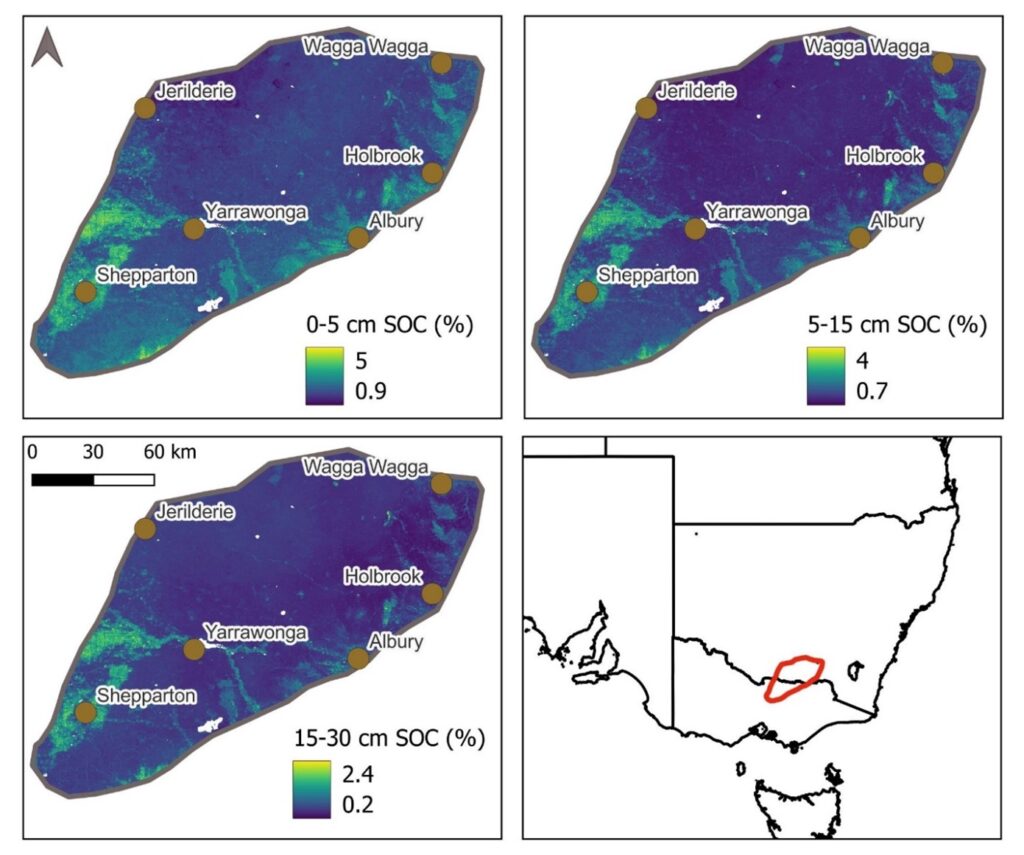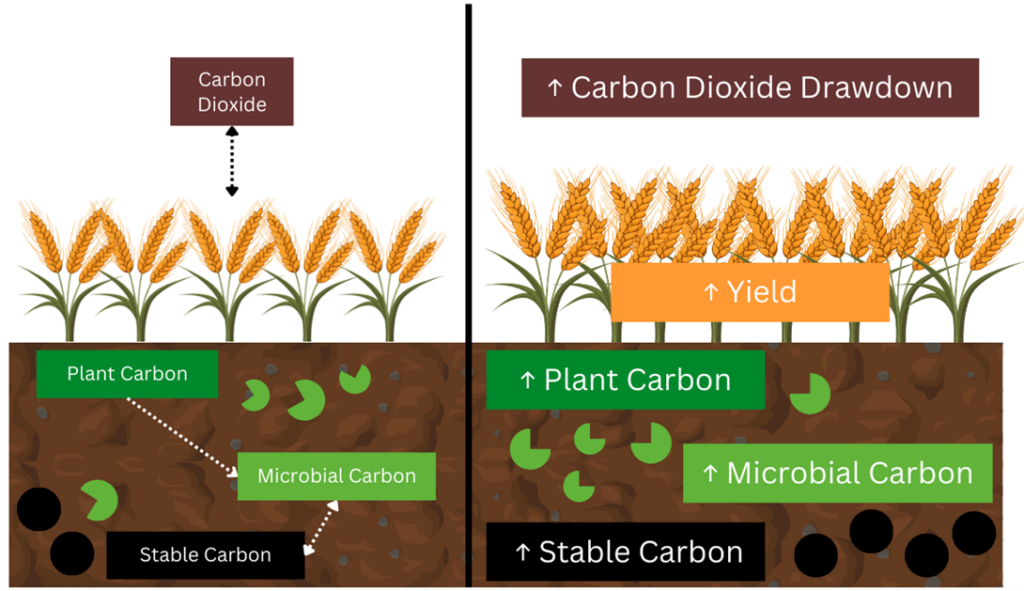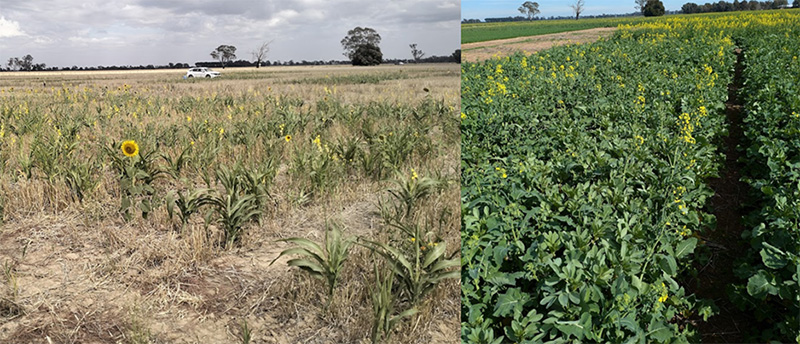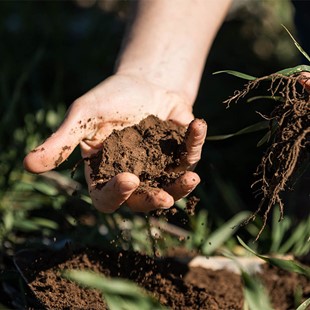This fact sheet supports the ‘Building soil carbon through land management strategies in the Riverine Plains, NSW’ webinar, delivered as part of the ‘Soil carbon capacity building resources for farmers and advisors’ project, proudly supported by the NSW Department of Climate Change, Energy, the Environment and Water (DCCEEW).
In this webinar Dr Abe Gibson, Soil Scientist and Research Fellow (Southern Cross University) and Dr Cassandra Schefe, Soil Scientist (AgriSci) explore:
- what soil carbon levels can be expected
- what factors influence soil carbon
- what management practices can be used to increase soil carbon levels.
Key messages
- Understand your soil carbon context – soil type, climate, soil properties, management.
- Management to promote plant growth is management to promote carbon.
- Know your limitations – soil, climate, land management.
- There are benefits to soil carbon management outside of the Emissions Reduction Fund (ERF).
Understand your soil carbon context
It is important to understand what your current soil carbon levels are before implementing management strategies to build soil carbon. Soil organic carbon (SOC) varies with soil type, climate and soil properties. For example, clay soils can hold more carbon due to a range of mechanisms by which clay prevents microbial and non-microbial breakdown of organic carbon.
Soils low in fertility generally have lower SOC, and other constraints to production restrict biomass input. Soil organic carbon generally increases with increasing mean annual rainfall (MAR).
SOC generally increases through the Riverine Plains footprint from the plains of the southwest (<1% SOC, ~450 mm MAR) to the foothills of the Great Dividing Range in the northeast (up to 5% SOC, 800 mm MAR) (Figure 1). Relatively high SOC levels are also found on the alluvial and irrigated systems in the west.
Land management practices influence soil carbon levels. Tillage damaging soil structure has led to declining levels of soil carbon in cropping systems. Pasture systems generally have higher levels of carbon due to less disturbance and more consistent input of biomass throughout the year, although McDonald et al. (2023) found no effect of grazing management on SOC.
Ley phases have been widely recognised to increase SOC, but that organic matter is generally cycled, releasing nutrients, through the rotation in the cropping phase. This process is beneficial but effectively results in a range where SOC fluctuates. For instance, research in the Central West of NSW showed that increases under various cropping and pasture systems decreased in later measurements due to seasonal conditions, rotation phase, or natural variability (Badgery et al., 2019; Simmons et al., in prep.).
What is important for the sustainable functioning of soil is that the range does not trend downwards. Each soil has a stable carbon storage capacity, not an ongoing linear increase, so manage expectations around potential increases.
Research in the Riverine Plains region and similar environments and farming systems has shown the limitations to increasing SOC. For example, little difference between pastures and cropping sites was observed by Day and Koen (2013) below 500 mm MAR. Conyers and co-authors (2015, 2024) found accumulation rates of 0.5 to 0.7 t/ha/y when moving from annual systems to well-managed perennial pastures. Increases in soil carbon achieved by addressing soil constraints can take 5-7 years to come through, and are commonly restricted to the surface layers (approximately top 30 cm). The increases are achieved from a low starting point, requiring the increases in biomass input and management of constraints to be sustained. Soil carbon gains tend to flatten out as the soil reaches a new equilibrium.
The intermittent input of organic matter in cropping systems means that it is likely to be difficult to increase SOC if already greater than approximately 1% (Conyers et al. 2015). More consistent increases, however, can be achieved by improving fertility (such as increasing phosphorus to meet yield targets), to increase productivity and the storage of stable forms of SOC (e.g. Chan et al., 2010; Coonan et al., 2019).
The LOOC-C tool (a landscape options and opportunities for carbon abatement calculator) can help you understand this context with some basic information about your enterprise.

Management to promote plant growth is management to promote carbon
Higher biomass production means higher input of soil carbon levels as plants draw carbon from the atmosphere. While growing, plants provide carbon to the soil via their root exudates, after senescence, shoots, leaves and roots enter the soil carbon cycle. Soil microbes and fungi will decompose this material, with this biomass then supporting larger fauna in the ecosystem. This soil ecosystem is an important component of the total soil carbon pool.
More biomass supports a larger ecosystem, meaning more soil carbon throughput (Figure 2). However, this does not automatically mean that more carbon is stored in the soil. If soil organisms keep up with the increased input of biomass, then the cycling of organic matter evens out. This cycling is vital for a living soil that supports agriculture and ecosystems.

Know your limitations
When considering a carbon project or implementing a change to build soil carbon, it is important to know your key limitations. It is important to be able to identify limitations to plant growth, limitations to carbon storage and practical limitations of your operation. Plant growth constraints such as acidity, hard pans or soil dispersion limit carbon accumulation.
Take the time to investigate any potential soil constraints and amelioration options. An effective soil testing program is needed to monitor and manage soil constraints and soil fertility to ensure plant nutrient demand is met. Yield maps can be a good starting point to find these on your property. Other key questions to ask when engaging with consultants are:
- What are my management and financial opportunities for practice change?
- What is my likely upper limit of soil carbon relative to my starting point?
- Over how much area can I make this practice change?
Benefits to maintaining or building soil carbon
Market instruments for sequestering carbon are an attractive option. They offer an additional source of income and are often advertised as reliable. This market is in its infancy in Australia, but there have been some promising results for graziers. Some credits awarded are well in excess of rates observed in research trials and seem in excess of what net primary production would supply. Such anomalies may be due to timing (e.g. see Mitchell et al., 2024). There are opportunities available for grain growers to participate, though achieving measured increases may be more challenging; more examples will come into the market soon.
It should be noted that if credits are sold to generate income, the producer no longer has rights to the sold soil carbon but is responsible for managing it. An alternative for producers is to retain ownership to decrease the emissions-intensity of their products.
While there have been few business cases to quantify the benefit of at least maintaining a ‘good’ level of SOC, or reaching such a level, improved nutrient cycling in the higher rainfall range of the region contributed in the order of $100/ha/year, while improved rainfall use efficiency in lower rainfall areas was worth ~$25/ha/year (Ringrose-Voase et al., 1997; Meyer et al., 2015). Such increases are in the range of addressing other constraints to production such as soil acidity or fertility.
Alongside credit-based schemes are payments for environmental stewardship. Instruments for direct payments or for generating levies are in development.
Maintenance or improvements of soil carbon are important for maintaining soil health. Good soil health supports nutrient cycling, soil structure and water holding capacity (Figure 3). Linking this to managing for plant growth, you can establish positive feedback that increases the productivity of your system. These links are evident in the ERF, as all the eligible activities are good agronomic practices.

Trial results indicate that building soil carbon using summer cover crop, intercropping and temporary intercropping treatments will be a slow process. While an increase in total soil carbon has not been measured from the research, there has been a positive response in early soil health indicators and reduced disease loads in the diverse systems trialled. Integrating summer cover crop, intercropping and temporary intercropping treatments should be considered as part of a planned rotation (see the ‘Plant-based solutions to improve soil performance’ fact sheet).
Summary
- Plant growth provides the foundation for building soil carbon. Promoting plant growth give you an opportunity to build soil carbon.
- The amount of soil carbon accumulation is controlled by the existing levels, soil type and properties and climate.
- Summer cover crops and intercropping are practices that can increase plant diversity and biomass in cropping systems. Summer cover crops need to be sown opportunistically, while intercropping may require modification to operations.
- Generating credits may be an option if potential to increase is high, but maintaining soil carbon is important for maintaining soil fertility and productivity.
- Showing stewardship of soil may help you leverage supply chains and maintain social license to operate.

Prepared by the Soil CRC and their participants as part of the ‘Soil Carbon Capacity Building Resources for Farmers and Advisors’ project, proudly supported by NSW DCCEEW.


